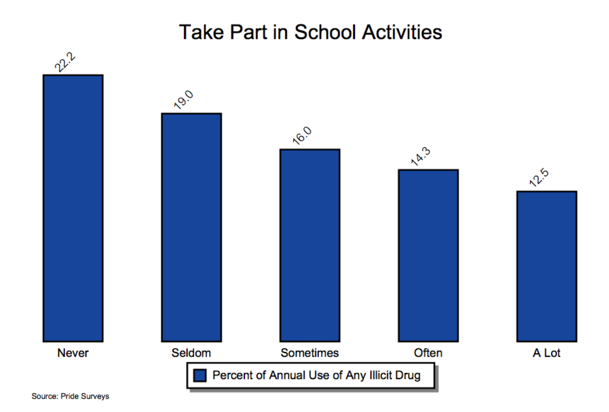Sign up for our information-filled email newsletter

The Impact of Taking Part in School Activities on Drug and Alcohol Use in Teens

Research shows there is a link between teen substance abuse and how well kids do in school. Teens who abuse drugs have lower grades, a higher absentee rate from school and other activities, and an increased potential for dropping out.[1] By participating in extracurricular activities like athletics, taking music lessons, or joining the newspaper staff, teens have a framework for their free time. They are also involved with a network of coaches, teammates and bandmates, and advisors who may be less tolerant of the use of illicit or illegal substances. While there is some debate about whether student-athletes, especially boys, are more susceptible to the influence of drugs from peers, most of the news is good.
In our Pride Surveys Report: 2015-16 National Summary, we noted that more than 30% of 6th and 7th graders take part in school activities “a lot” as do about 24% of 11th and 12th graders.[2] In the national summary, you can see the correlations between extracurricular activities and drug use in our chapter that cross-tabs risk and protective factors with substance use.
High school girls who participate in sports are significantly less likely to use marijuana, cocaine, or most other illicit drugs. This protective effect of sports appears to be most influential for white girls. Some research does suggest that girls may be at a higher risk of illicit drug use than boys because they are more vulnerable to influences such as partner, peer or parental drug use. This statistic changes though when girls participate in sports, showing lower rates of drug use by female athletes as compared to their non-athlete peers.[3]
Sports help keep girls active and make them feel like a part of a team, which in turn can lead to a desire to be their healthiest and perform their best as well as a feeling of accountability towards other team members.[4] A national study of U.S. public high school students even found organized sports participants were 22% less likely to smoke cigarettes. Both male and female high school students who were involved in sports tended to rate themselves as being popular and more involved in extra-curricular activities. Playing sports and being part of a team can also give youth a strong social network that allows them to develop social skills that help them better adjust at school.[5]
However, a study published in the Journal of Child & Adolescent Substance Abuse does reveal that those most at risk for addiction to pain medications are sometimes high school athletes.[6] One of the key findings of this survey was that high school athletes more commonly used drugs than their peers; another was that boys were more likely to be drug users than girls. Finally, it was found that football players led their peers in drug use. One of the most troubling findings in the survey was that more teens are abusing prescription drugs including painkillers.[7]
What does all of this mean? It’s essential that parents are involved in their child’s lives and begin having conversations early about alcohol, tobacco, and other drugs. If a teen believes that his or her parents will allow substance use, he or she is more likely to try drugs or alcohol.[8] Substance abuse can lead to addiction or incarceration or other problems such as poor schoolwork, loss of friends, problems at home, and lasting legal problems.
It’s important for parents, educators, and coaches to learn about community and school activities that may interest teens and encourage them to participate. Relationships with educators and counselors are among the most significant and influential ones for many students. Adolescents who perceive that their teachers care about them are less likely to start using marijuana, smoking cigarettes, drinking to get drunk, and other behaviors that are barriers to education.[9]
But if school sports or other activities are not appealing to your teens, consider volunteer opportunities. Volunteering or after-school jobs can provide young people with a chance to become more responsible, to be exposed to other adults, and to develop new skills and interests. Some families even look for opportunities for teens and parents to volunteer together. It’s important, though, to remember not to push too hard. Look for signs that teens are overwhelmed with activities, volunteering, school work and other obligations.
Pride Surveys developed its Risk and Protective Factor (RPF) student perception survey, a hybrid version of the Communities That Care (CTC) Youth Survey and the Pride Questionnaire for Grades 6 to 12 to measure the factors that show the strongest correlations to drug use. It contains the updated Core Measures required by the Substance Abuse and Mental Health Services Administration (SAMHSA) for their Drug-Free Communities Grant that went into effect February 2013 and asks about incidences of alcohol, tobacco, and other drug use plus perceptions of availability and disapproval of use from parents and friends.
For over thirty years, Pride Surveys has been helping schools collect data on teen substance abuse perceptions and drug use trends in communities through scalable survey products. We offer multiple drug-free community survey options as well as student risk perception surveys designed to help assess teen substance abuse and risk, including our student surveys for grades 4-6, grades 6-12, and our supplemental surveys like the Drug-Free Community Survey Supplement. Please contact us online or call (800) 279-6361 for more information.
[1] “Adolescent Substance Abuse: America’s #1 Health Problem.” Retrieved 26 January, 2018 at https://www.centeronaddiction.org/addiction-research/reports/adolescent-substance-use-america%E2%80%99s-1-public-health-problem
[2] “Pride Surveys Questionnaire for Grades 6 thru 12 Standard Report 2015-16 Pride National Summary.” Retrieved 26 January, 2018 at https://www.pridesurveys.com/customercenter/us15ns.pdf
[3] “HER LIFE DEPENDS ON IT III: Sport, Physical Activity, and the Health and Well-Being of American Girls and Women Executive Summary.” Retrieved 26 January, 2018 at http://www.womenssportsfoundation.org/wp-content/uploads/2017/06/hldoi-iii-report-executive-summary.pdf
[4] “Her Life Depends On It III: Sport, Physical Activity, and the Health and Well-Being of American Girls and Women Executive Summary.” Retrieved 26 January, 2018 at http://www.womenssportsfoundation.org/wp-content/uploads/2017/06/hldoi-iii-report-executive-summary.pdf
[5] “How Your Daughter’s Sports Team Could Be Enhancing Your Family Life.” Retrieved 26 January, 2018 at https://www.womenssportsfoundation.org/education/how-your-daughters-sports-team-could-be-enhancing-your-family-life/
[6] “Abuse of Prescription Painkillers on the Rise Among High School Athletes: Survey.” Retrieved 26 January, 2018 at https://health.usnews.com/health-news/articles/2014/08/04/abuse-of-prescription-painkillers-on-the-rise-among-high-school-athletes-survey
[7] “Survey Says High School Athletes More At Risk for Prescription Abuse Problems.” Retrieved 26 January, 2018 at http://www.narconon.org/blog/narconon/survey-says-high-school-athletes-risk-prescription-abuse-problems/
[8] “Talking to your middle school-aged child about alcohol, tobacco, and other drugs: a 10-step guide for parents.” Retrieved 26 January, 2018 at http://www.needhamma.gov/DocumentCenter/Home/View/3387
[9] “The Role of Schools in Combatting Illicit Substance Abuse.” Retrieved January 26 at http://pediatrics.aappublications.org/content/120/6/1379#ref-2

- How Substance Abuse And Mental Health Issues Impact Each Other
- Red Ribbon Week | Youth Drug Use Statistics and Prevention
- Vaping or E-Cigarette Usage and Resources
- Top Five Reasons to Survey Your Students Every Year
- Pride Surveys’ Top 9 Blog Posts of 2019




 (3 votes, average: 3.33 out of 5)
(3 votes, average: 3.33 out of 5)

